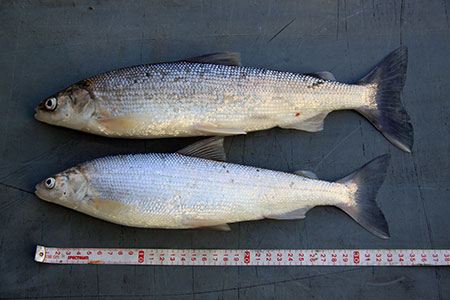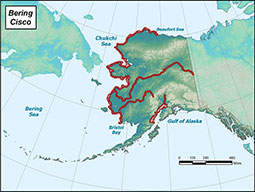Bering Cisco
(Coregonus laurettae)
Printer Friendly
Did You Know?
Unlike Pacific salmon, some Bering cisco may not die after spawning.
General Description
The Bering cisco is a medium-sized, salmonid-like fish up to 18 inches in total length. Bering cisco is distinguished from least cisco by pale, almost colorless pelvic and pectoral fins. Bering cisco is distinguished from the arctic cisco by the smaller number of gill rakers on the lower portion of the first gill arch.
Adult Bering cisco are generally brownish to dark green dorsally with silvery lower sides and belly. The anal, pelvic, and pectoral fins are pale, caudal and dorsal fins are dusky in color. Bering cisco may have black dots with halos along their backs, and/or white spots on the fins.
Life History
Growth and Reproduction
Bering ciscos are anadromous which means they spend part of their lives in the ocean and part of their lives in fresh water. Bering cisco are known to rear in coastal waters, estuaries, and river mouths until mature, when they migrate upstream to spawn. Sexually mature, adult Bering cisco, ranging in age from 4 - 12 years old, undertake extreme spawning migrations into freshwater systems, traveling over 500 miles up the Kuskokwim River and over 1,200 miles up the Yukon River. Depending on her size, a female Bering cisco may release up to 34,000 eggs. Some Bering cisco may not die after spawning. Whitefish eggs are negatively buoyant and non-adhesive. The female broadcasts her eggs over loosely compacted gravel beds in turbid and swiftly flowing water. The eggs presumably hatch in the spring and the young descend downstream to feed and rear in brackish estuarine habitat.
Feeding Ecology
Juvenile and adult Bering cisco are schooling species which feed on small fishes, amphipods and other invertebrates in the near shore environment. Bering cisco are known to be more tolerant of the higher saline waters that occur offshore in the marine environment. However, Bering cisco cannot survive the cold temperature of sea water under ice (1.7° C) and so must retreat to estuaries and river mouths in winter where water temperatures are not as cold. Adult Bering cisco do not feed during spawning migrations.
Migration
Anadromous Bering cisco typically migrates into freshwater systems in late spring to late summer to spawn. Spawning occurs in October. Bering cisco are known to spawn in the turbid and braided mainstem of the Susitna River, the mainstem of the Yukon River, and in the turbid and highly braided South Fork Kuskokwim River.
Range and Habitat
In Alaska, Bering cisco are found from the Kenai Peninsula (likely rearing fish from the Susitna River), north along the Bering Sea drainages, and east along the Arctic Coast to the Colville River. The only rivers where spawning runs have been documented are the Susitna, Kuskokwim, and Yukon Rivers.
Status, Trends, and Threats
Status
Several studies have been conducted on Bering cisco populations by a number of agencies over the years. Research indicates that Susitna, Kuskokwim, and Yukon River populations are quite distinct. Such information is very useful when conducting mixed stock analysis on fish collections of unknown origin.
Trends
Overall strength of Bering cisco returns varies across the state by year and location. Currently there is not sufficient data to access the relative abundance of Bering cisco within or between known populations throughout the state.
Threats
Potential overharvest from commercial, personal use or subsistence fisheries is one threat to the resource. This species is essentially endemic to Alaska, which means they are prevalent in or peculiar to a particular location or region. The migratory behavior of Bering cisco makes the species susceptible to local habitat alteration, disturbance or degradation. Bering cisco tend to be slow-growing, late maturing, and are the shortest lived whitefish species (except perhaps the pygmy whitefish in some locations) which leaves them vulnerable to large-scale disasters. Other major ecological changes, such as those associated with the effects of global warming, could adversely affect Bering cisco populations.
Fast Facts
-
Size:
The Bering cisco is a medium-sized fish known to reach a length of over 18 inches, but is generally smaller. -
Range/Distribution:
Coastal range from the mouth of the Susitna River and coastal waters of Cook Inlet, north along the Bering Sea and east along the Arctic Coast as far east as the Colville River. -
Diet:
Amphipods and other pelagic invertebrates, small fishes such as sticklebacks. -
Predators:
Variety of marine mammals, fishes, and birds. -
Reproduction:
Bering cisco mature at about 4 years old. Unlike Pacific salmon, some Bering cisco may not die after spawning. -
Remarks:
Managed by the Alaska Department of Fish & Game in Alaska state waters.
Did You Know?
- Only three known populations of Bering cisco are known worldwide, all of which are in Alaska.
- Bering cisco may migrate from 500 to over 1,000 miles upstream to spawning grounds.
- Bering cisco are an important subsistence fish species for coastal and lower river communities located within drainages of the Yukon and Kuskokwim Rivers.
- Like Pacific salmon, Bering cisco are anadromous.
- Unlike Pacific salmon, some Bering cisco may not die after spawning.
Uses
The Bering cisco is known to be an important subsistence fish species for coastal and lower river communities located within drainages of the Yukon and Kuskokwim Rivers. A commercial fishery in the lower Yukon River estuary targeting Bering cisco has been ongoing since 2005. The fishery occurs annually between September and December and harvest cap allows for a combined harvest total of 20,000 pounds for all species of whitefish.
Management
Both commercial and subsistence fishers target Bering cisco. The Commercial Fisheries Division of ADF&G manages these fisheries in Alaska. Subsistence surveys are conducted by both Commercial Fisheries and Subsistence divisions. There are no directed sport fisheries for Bering cisco in Alaska.
Research
Numerous research projects have been conducted on Bering cisco throughout Alaska. The Alaska Department of Fish and Game, U.S. Fish and Wildlife Service, and University of Alaska have all studied Bering cisco in recent years. ADF&G projects include documentation of traditional ecological knowledge (TEK) and assessments of subsistence harvests for non-salmon species such as whitefish. A University of Alaska project aims to determine the stock composition of Bering cisco populations in the lower Yukon River by examining the strontium isotope composition of the fish’s otoliths (ear bones). U.S. Fish and Wildlife Service projects have sought to identify spawning habitats and spawning migration patterns in some reaches of the Yukon and Kuskokwim River drainages. Many of these projects use radio telemetry (biologists place radio transmitter tags into fish and then follow the signal in order to track the fish's movements). The information gathered is used to better manage and protect Bering cisco stocks and habitat.
Get Involved
There are a number of ways to get involved in the regulatory process for Bering cisco. Since the State of Alaska is responsible for managing Bering cisco fisheries throughout the state, you can participate by attending Alaska Board of Fisheries (BOF) meetings, local advisory committee meetings or writing proposals to the BOF.
Alaska Board of Fisheries
The Board of Fisheries meets four to six times per year in communities around the state to consider proposed changes to fisheries regulations. The board uses the biological and socioeconomic information provided by the Alaska Department of Fish and Game, public comment received from people inside and outside of the state, and guidance from the Alaska Department of Public Safety and Alaska Department of Law when creating regulations that are sound and enforceable. The public can submit proposed changes and comment on proposals prior to deliberation through written or oral means. The public is also encouraged to participate in their local advisory committee. Eighty-one committees throughout the state provide recommendations to the BOF on a variety of issues. For more information see: Board of Fisheries


